Abstract
OBJECTIVE: To ascertain whether the quality of physician-patient communication makes a significant difference to patient health outcomes. DATA SOURCES: The MEDLINE database was searched for articles published from 1983 to 1993 using "physician-patient relations" as the primary medical subject heading. Several bibliographies and conference proceedings were also reviewed. STUDY SELECTION: Randomized controlled trials (RCTs) and analytic studies of physician-patient communication in which patient health was an outcome variable. DATA EXTRACTION: The following information was recorded about each study: sample size, patient characteristics, clinical setting, elements of communication assessed, patient outcomes measured, and direction and significance of any association found between aspects of communication and patient outcomes. DATA SYNTHESIS: Of the 21 studies that met the final criteria for review, 16 reported positive results, 4 reported negative (i.e., nonsignificant) results, and 1 was inconclusive. The quality of communication both in the history-taking segment of the visit and during discussion of the management plan was found to influence patient health outcomes. The outcomes affected were, in descending order of frequency, emotional health, symptom resolution, function, physiologic measures (i.e., blood pressure and blood sugar level) and pain control. CONCLUSIONS: Most of the studies reviewed demonstrated a correlation between effective physician-patient communication and improved patient health outcomes. The components of effective communication identified by these studies can be used as the basis both for curriculum development in medical education and for patient education programs. Future research should focus on evaluating such educational programs.
Full text
PDF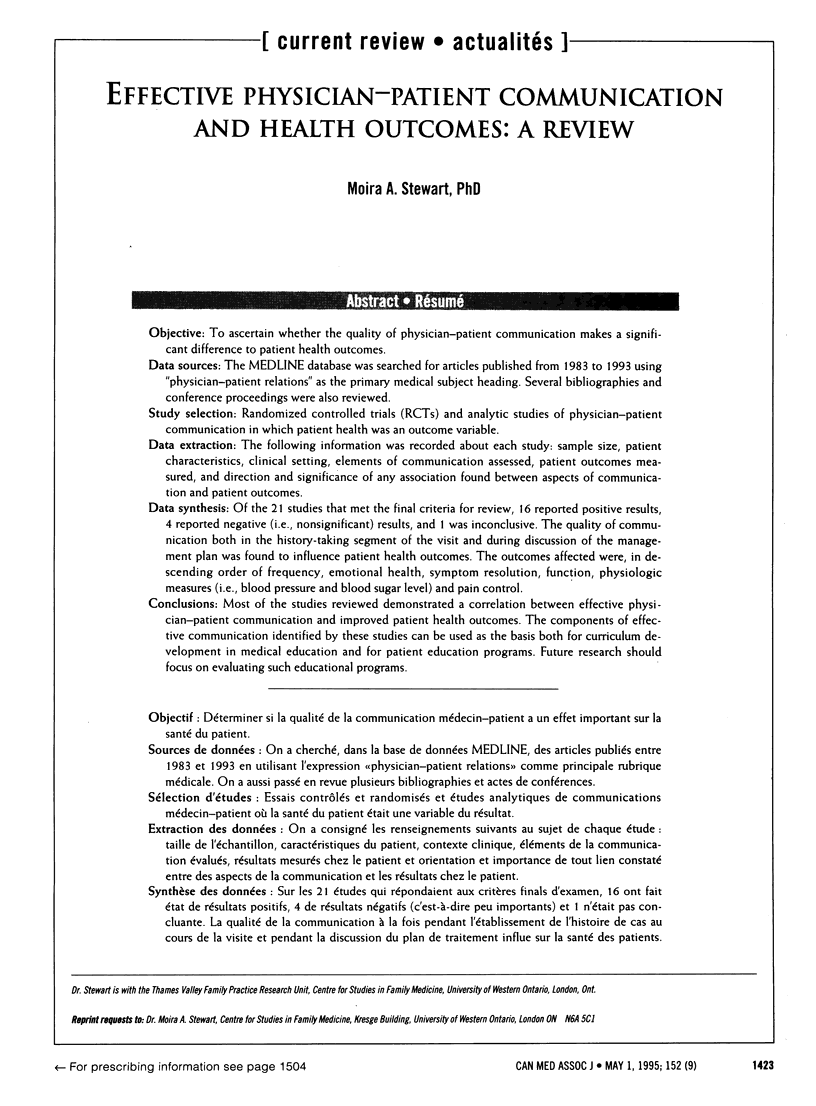
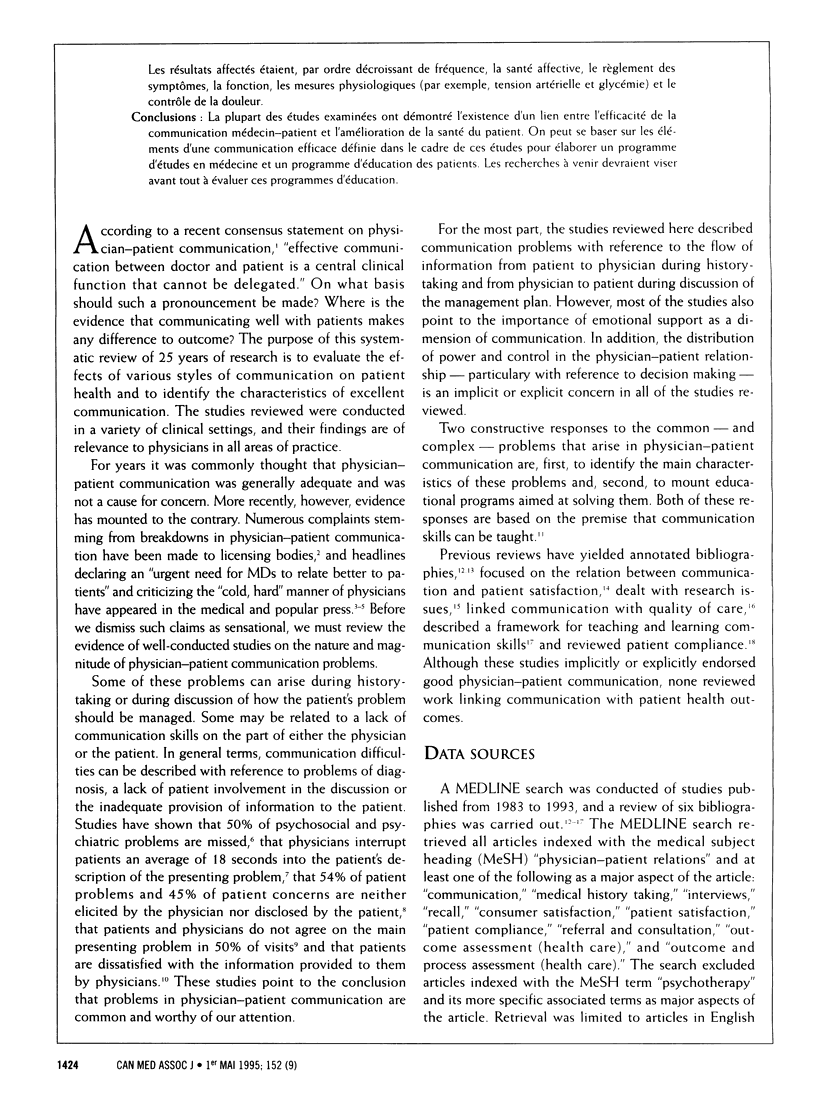
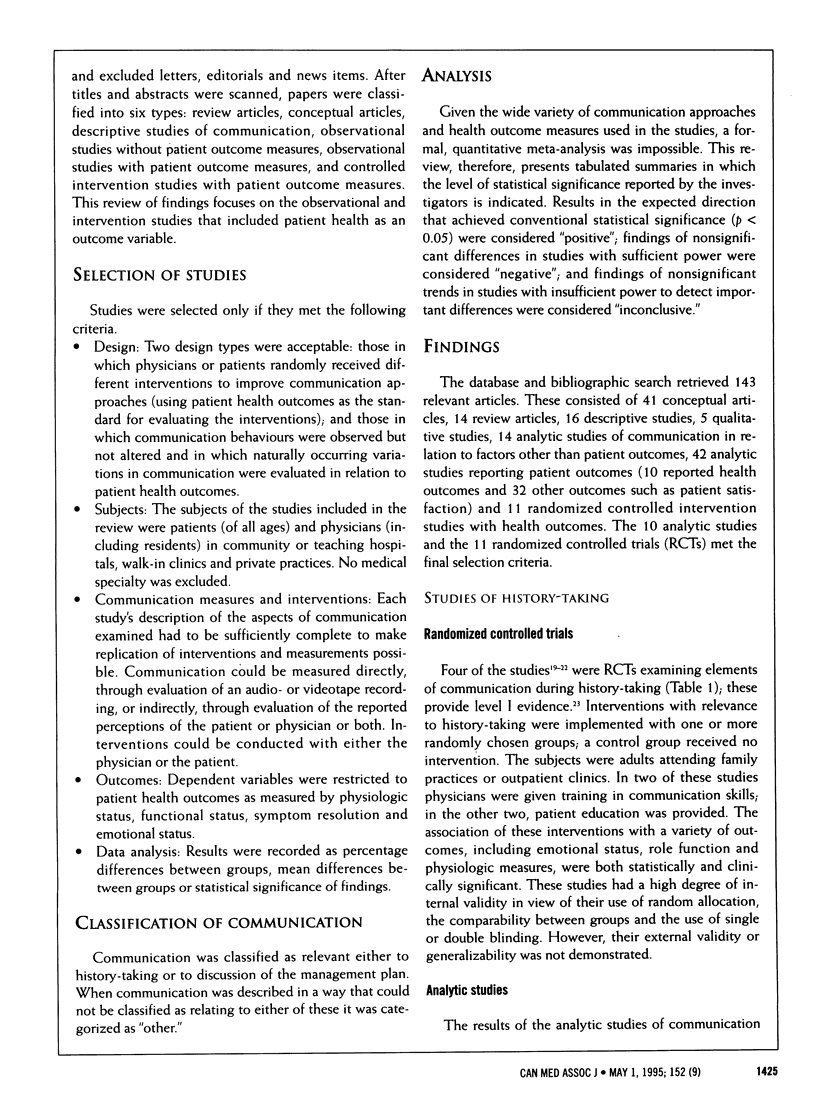
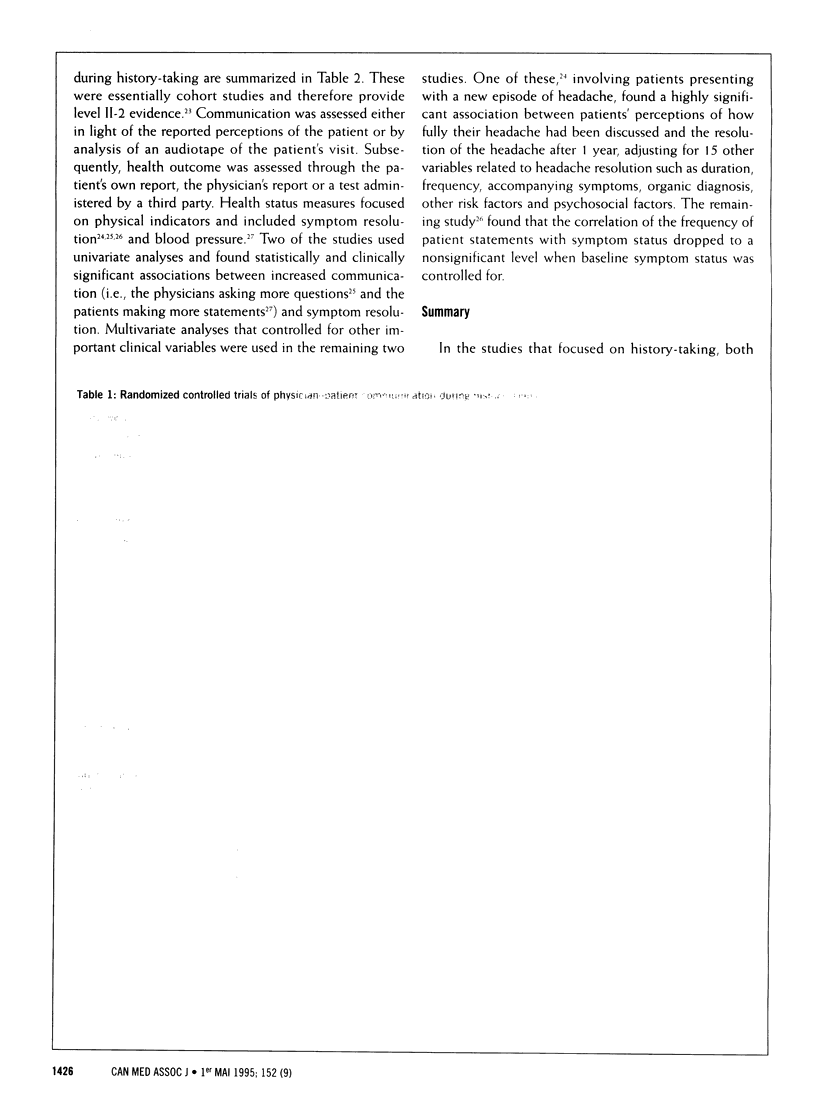
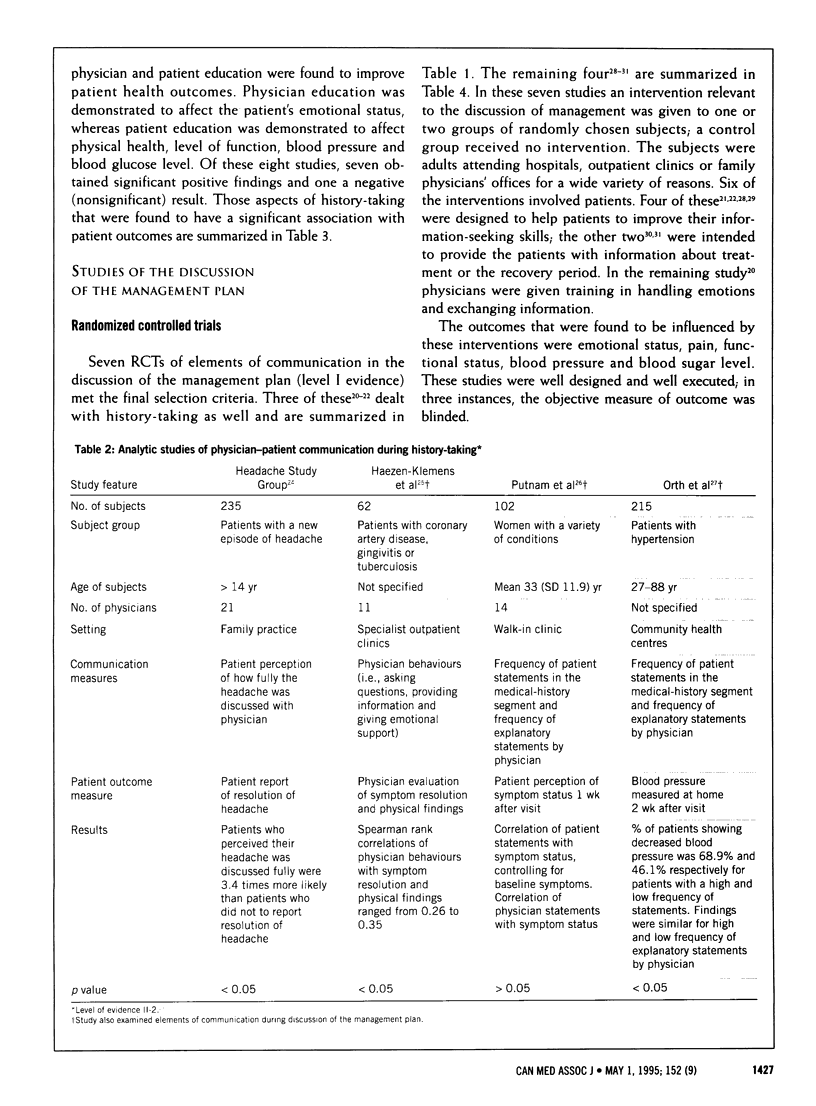
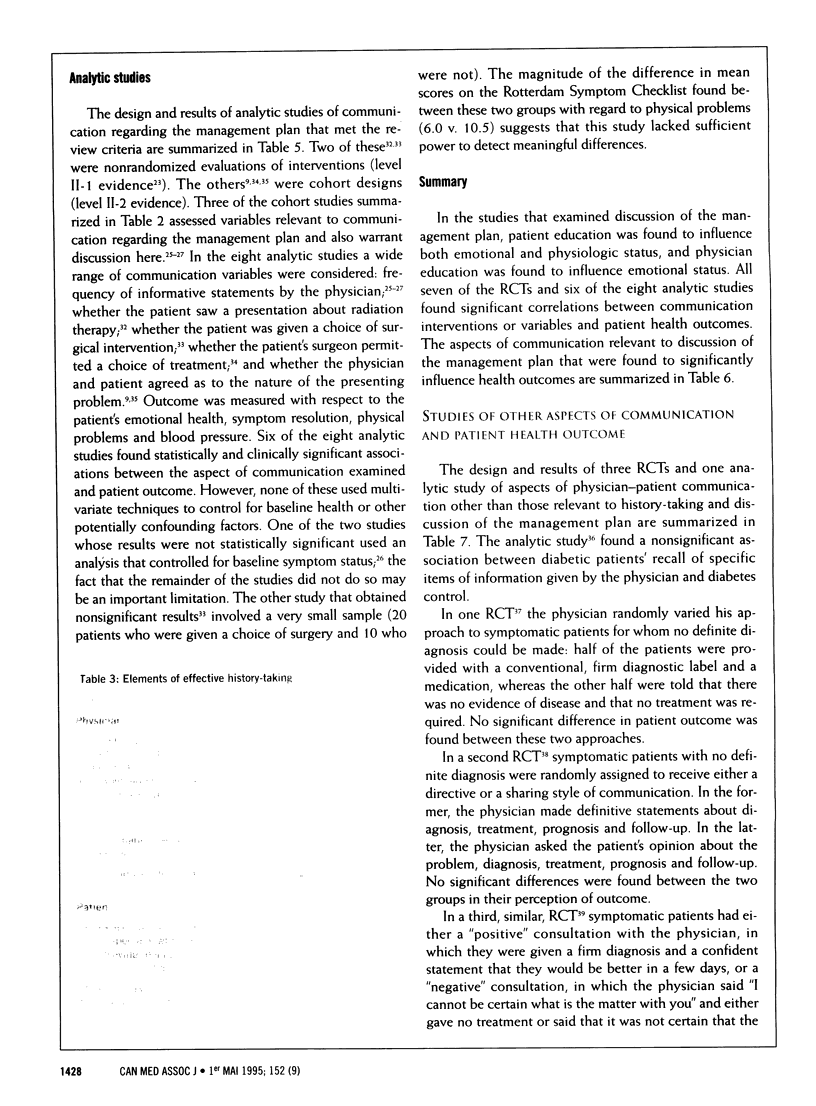
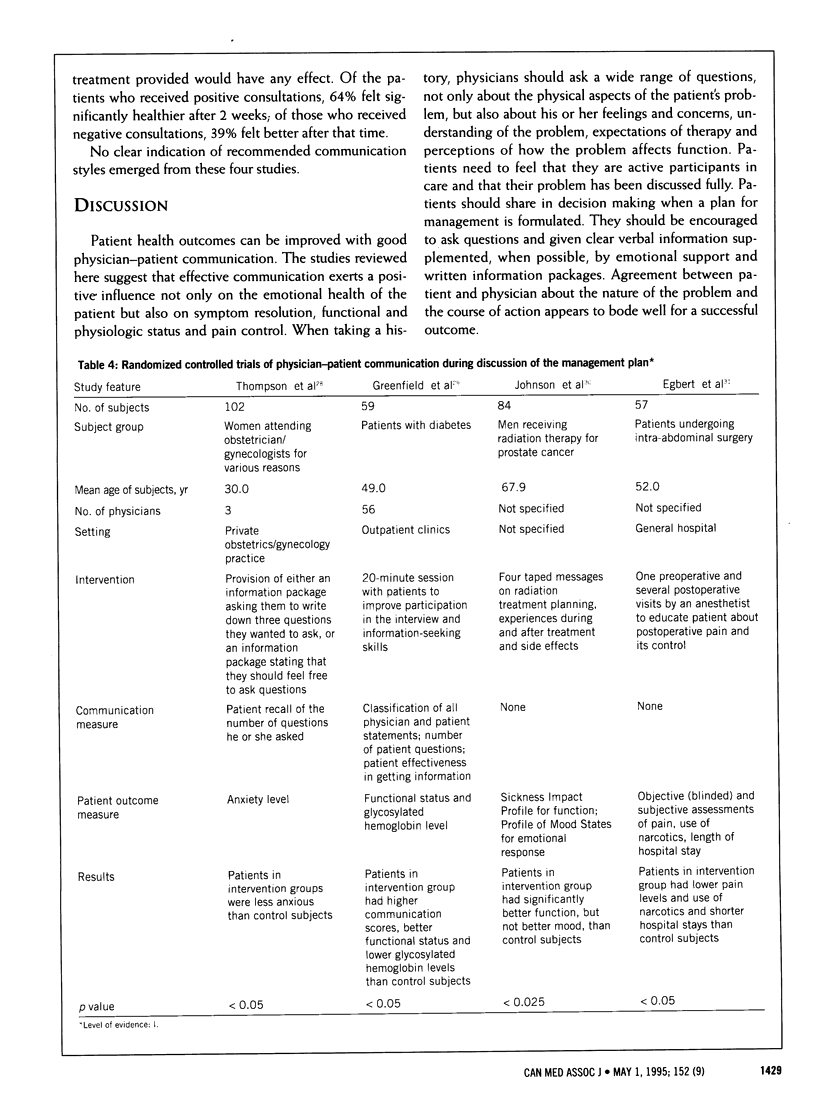
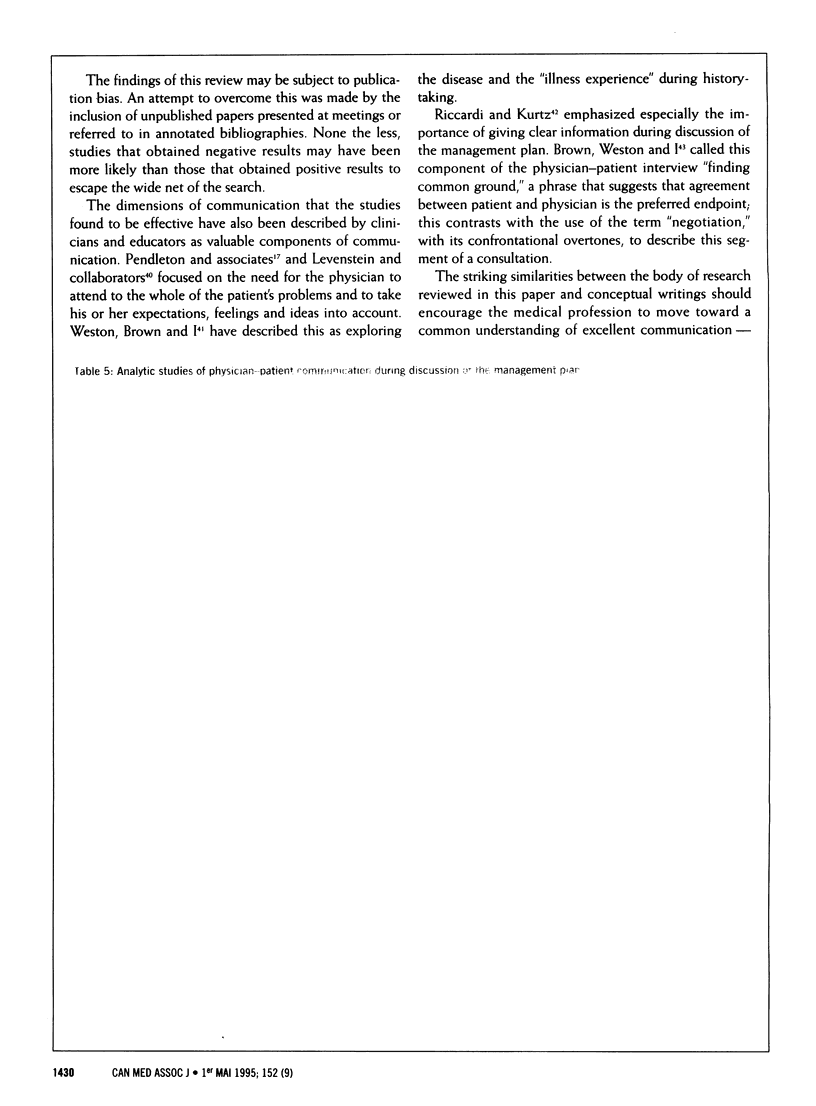
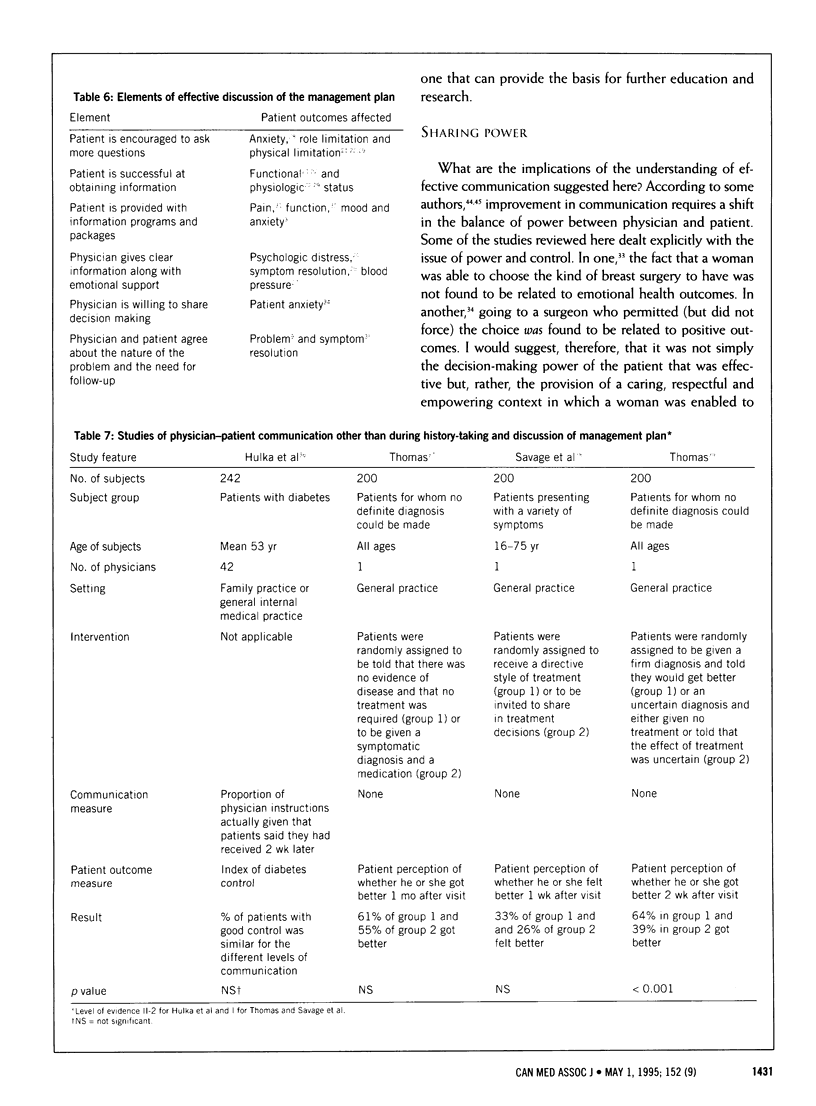
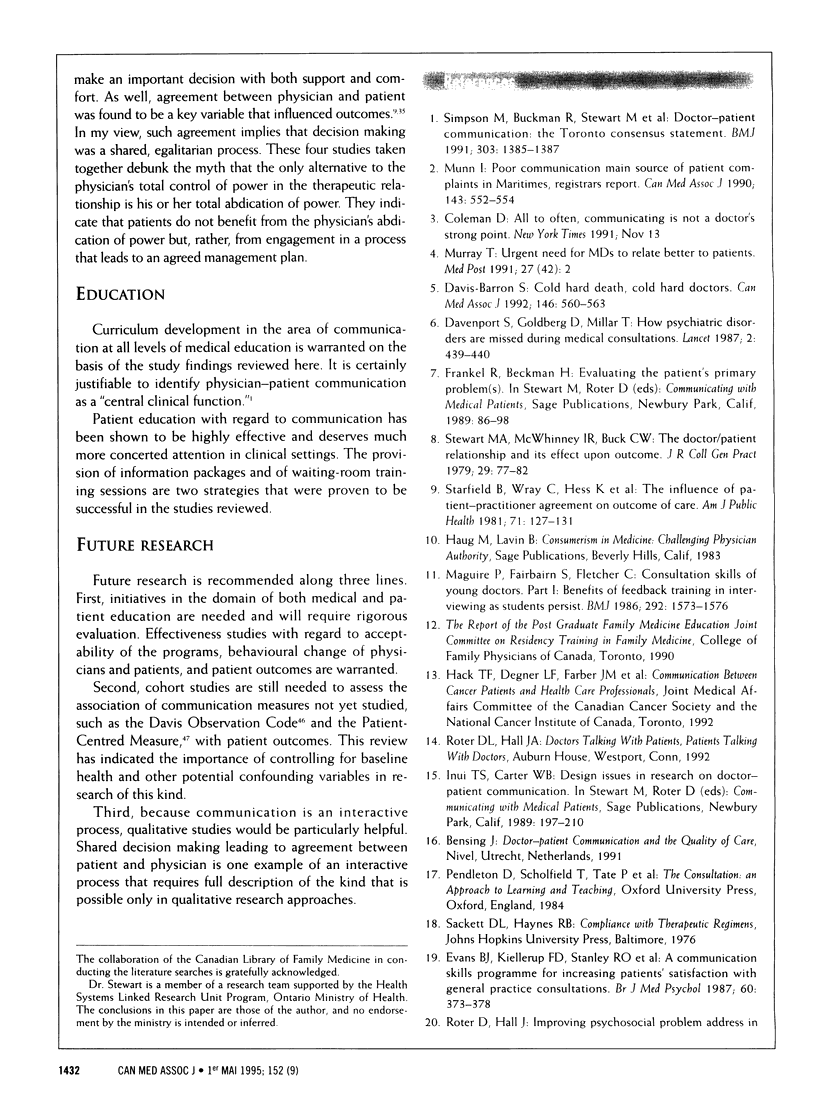
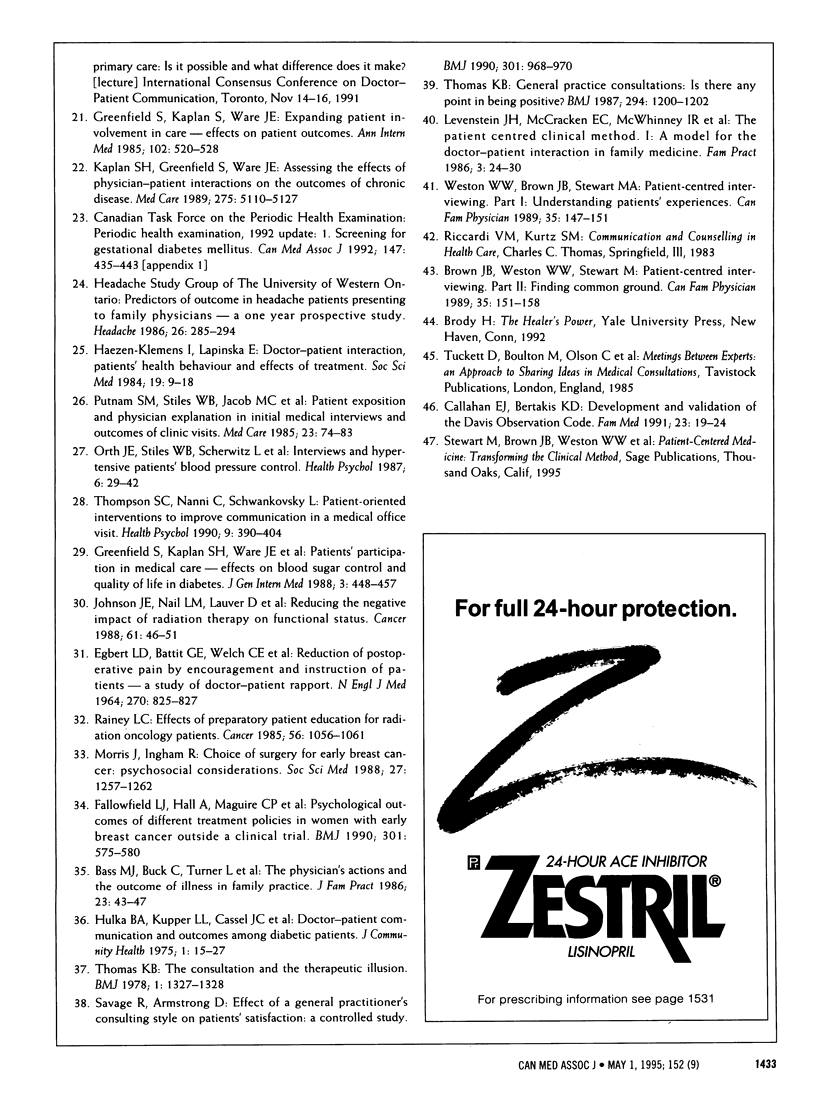
Selected References
These references are in PubMed. This may not be the complete list of references from this article.
- Bass M. J., Buck C., Turner L., Dickie G., Pratt G., Robinson H. C. The physician's actions and the outcome of illness in family practice. J Fam Pract. 1986 Jul;23(1):43–47. [PubMed] [Google Scholar]
- Callahan E. J., Bertakis K. D. Development and validation of the Davis Observation Code. Fam Med. 1991 Jan;23(1):19–24. [PubMed] [Google Scholar]
- Davenport S., Goldberg D., Millar T. How psychiatric disorders are missed during medical consultations. Lancet. 1987 Aug 22;2(8556):439–441. doi: 10.1016/s0140-6736(87)90970-6. [DOI] [PubMed] [Google Scholar]
- Davis-Barron S. Cold hard death, cold hard doctors. CMAJ. 1992 Feb 15;146(4):560–563. [PMC free article] [PubMed] [Google Scholar]
- EGBERT L. D., BATTIT G. E., WELCH C. E., BARTLETT M. K. REDUCTION OF POSTOPERATIVE PAIN BY ENCOURAGEMENT AND INSTRUCTION OF PATIENTS. A STUDY OF DOCTOR-PATIENT RAPPORT. N Engl J Med. 1964 Apr 16;270:825–827. doi: 10.1056/NEJM196404162701606. [DOI] [PubMed] [Google Scholar]
- Evans B. J., Kiellerup F. D., Stanley R. O., Burrows G. D., Sweet B. A communication skills programme for increasing patients' satisfaction with general practice consultations. Br J Med Psychol. 1987 Dec;60(Pt 4):373–378. doi: 10.1111/j.2044-8341.1987.tb02756.x. [DOI] [PubMed] [Google Scholar]
- Fallowfield L. J., Hall A., Maguire G. P., Baum M. Psychological outcomes of different treatment policies in women with early breast cancer outside a clinical trial. BMJ. 1990 Sep 22;301(6752):575–580. doi: 10.1136/bmj.301.6752.575. [DOI] [PMC free article] [PubMed] [Google Scholar]
- Greenfield S., Kaplan S. H., Ware J. E., Jr, Yano E. M., Frank H. J. Patients' participation in medical care: effects on blood sugar control and quality of life in diabetes. J Gen Intern Med. 1988 Sep-Oct;3(5):448–457. doi: 10.1007/BF02595921. [DOI] [PubMed] [Google Scholar]
- Greenfield S., Kaplan S., Ware J. E., Jr Expanding patient involvement in care. Effects on patient outcomes. Ann Intern Med. 1985 Apr;102(4):520–528. doi: 10.7326/0003-4819-102-4-520. [DOI] [PubMed] [Google Scholar]
- Heszen-Klemens I., Lapińska E. Doctor-patient interaction, patients' health behavior and effects of treatment. Soc Sci Med. 1984;19(1):9–18. doi: 10.1016/0277-9536(84)90132-1. [DOI] [PubMed] [Google Scholar]
- Hulka B. S., Kupper L. L., Cassel J. C., Mayo F. Doctor-patient communication and outcomes among diabetic patients. J Community Health. 1975 Fall;1(1):15–27. doi: 10.1007/BF01318940. [DOI] [PubMed] [Google Scholar]
- Johnson J. E., Nail L. M., Lauver D., King K. B., Keys H. Reducing the negative impact of radiation therapy on functional status. Cancer. 1988 Jan 1;61(1):46–51. doi: 10.1002/1097-0142(19880101)61:1<46::aid-cncr2820610109>3.0.co;2-2. [DOI] [PubMed] [Google Scholar]
- Levenstein J. H., McCracken E. C., McWhinney I. R., Stewart M. A., Brown J. B. The patient-centred clinical method. 1. A model for the doctor-patient interaction in family medicine. Fam Pract. 1986 Mar;3(1):24–30. doi: 10.1093/fampra/3.1.24. [DOI] [PubMed] [Google Scholar]
- Maguire P., Fairbairn S., Fletcher C. Consultation skills of young doctors: I--Benefits of feedback training in interviewing as students persist. Br Med J (Clin Res Ed) 1986 Jun 14;292(6535):1573–1576. doi: 10.1136/bmj.292.6535.1573. [DOI] [PMC free article] [PubMed] [Google Scholar]
- Morris J., Ingham R. Choice of surgery for early breast cancer: psychosocial considerations. Soc Sci Med. 1988;27(11):1257–1262. doi: 10.1016/0277-9536(88)90355-3. [DOI] [PubMed] [Google Scholar]
- Orth J. E., Stiles W. B., Scherwitz L., Hennrikus D., Vallbona C. Patient exposition and provider explanation in routine interviews and hypertensive patients' blood pressure control. Health Psychol. 1987;6(1):29–42. doi: 10.1037//0278-6133.6.1.29. [DOI] [PubMed] [Google Scholar]
- Putnam S. M., Stiles W. B., Jacob M. C., James S. A. Patient exposition and physician explanation in initial medical interviews and outcomes of clinic visits. Med Care. 1985 Jan;23(1):74–83. doi: 10.1097/00005650-198501000-00008. [DOI] [PubMed] [Google Scholar]
- Rainey L. C. Effects of preparatory patient education for radiation oncology patients. Cancer. 1985 Sep 1;56(5):1056–1061. doi: 10.1002/1097-0142(19850901)56:5<1056::aid-cncr2820560516>3.0.co;2-z. [DOI] [PubMed] [Google Scholar]
- Savage R., Armstrong D. Effect of a general practitioner's consulting style on patients' satisfaction: a controlled study. BMJ. 1990 Oct 27;301(6758):968–970. doi: 10.1136/bmj.301.6758.968. [DOI] [PMC free article] [PubMed] [Google Scholar]
- Simpson M., Buckman R., Stewart M., Maguire P., Lipkin M., Novack D., Till J. Doctor-patient communication: the Toronto consensus statement. BMJ. 1991 Nov 30;303(6814):1385–1387. doi: 10.1136/bmj.303.6814.1385. [DOI] [PMC free article] [PubMed] [Google Scholar]
- Starfield B., Wray C., Hess K., Gross R., Birk P. S., D'Lugoff B. C. The influence of patient-practitioner agreement on outcome of care. Am J Public Health. 1981 Feb;71(2):127–131. doi: 10.2105/ajph.71.2.127. [DOI] [PMC free article] [PubMed] [Google Scholar]
- Stewart M. A., McWhinney I. R., Buck C. W. The doctor/patient relationship and its effect upon outcome. J R Coll Gen Pract. 1979 Feb;29(199):77–81. [PMC free article] [PubMed] [Google Scholar]
- Thomas K. B. General practice consultations: is there any point in being positive? Br Med J (Clin Res Ed) 1987 May 9;294(6581):1200–1202. doi: 10.1136/bmj.294.6581.1200. [DOI] [PMC free article] [PubMed] [Google Scholar]
- Thomas K. B. The consultation and the therapeutic illusion. Br Med J. 1978 May 20;1(6123):1327–1328. doi: 10.1136/bmj.1.6123.1327. [DOI] [PMC free article] [PubMed] [Google Scholar]
- Thompson S. C., Nanni C., Schwankovsky L. Patient-oriented interventions to improve communication in a medical office visit. Health Psychol. 1990;9(4):390–404. doi: 10.1037//0278-6133.9.4.390. [DOI] [PubMed] [Google Scholar]


